Abstract
To determine the speed of a vehicle in a collision with body deformation, the kinetic energy input of the vehicle to cause body damage must be estimated. This paper analyzes the methods for estimating the energy equivalent of vehicle damage. A finite element model of a Toyota Yaris developed by the National Crash Analysis Center (NCAC) for use in the LS DYNA R.11.0.0 software environment is used for the simulation. The simulations include tests of the vehicle hitting a non-deformable wall, an object simulating a pole or a tree. The residual deformations obtained are used to determine the energy equivalent speed (EES) values using the “Crash 3—EBS Calculation 12.0” software and a visual comparison with the EES catalog database, where the EES parameter value is recalculated to take into account the difference in the mass of the vehicles.
1. Introduction
According to the World Health Organization, approximately 1.19 million people die in road traffic accidents every year [1]. This high number of fatalities is a clear indication that road traffic accidents are still a major problem worldwide [2]. To tackle this problem, it is essential to identify the causes of accidents, as well as to design and implement measures to prevent them or at least minimize their possible negative consequences. Therefore, it is important to understand how vehicles behave in each accident, what processes are involved in the deformation of a vehicle, and what risks are posed to the occupants as well as the driver inside a vehicle [3]. It is important to analyze these issues in detail and to evaluate the data obtained, as they can be used to improve both vehicle safety and road infrastructure.
In traffic accident investigations, it is often necessary to calculate the speed of the vehicle. In a collision, when the contact between the vehicles is either a direct impact or a sideswipe, the body of the vehicle is always deformed. To calculate the speed of the vehicle in such a collision, it is necessary to consider the kinetic energy input of the vehicle to the damage to the body. Therefore, it can be argued that assessment of body deformation is of great importance in expert practice, but calculation of the energy equivalent of vehicle damage can be difficult due to a lack of sufficient data on the stiffness values of car bodies.
The Equivalent Barrier Speed (EBS) concept proposed by Mackay is used to compare the deformation of a vehicle in real accidents with its deformation in crash tests. The EBS concept is understood as the speed of an impact with a solid, non-deformable barrier at which the damage to the vehicle is the same as in a real accident. The German researchers H. Burg and F. Zeidler proposed denoting the kinetic energy converted into the deformation energy as the Energy Equivalent Speed (EES) and subsequently using this parameter [4]. The EES parameter describes the strain energy as the difference between the sum of the kinetic energies of the colliding vehicles immediately before the collision and the sum of the same energies after the collision, considering only the residual plastic deformations of the vehicle [5,6,7,8]. Mackay’s method is based on the principle that all kinetic energy is converted into deformation energy during the test, but in reality, only a part of the kinetic energy is converted into residual plastic deformation during the impact with the rigid barrier [9]. Due to the plasticity of the vehicle body, part of the (dynamic) deformation is converted back into kinetic energy, and only in a fully plastic collision do the EBS and EES parameters coincide. For a direct central impact, the EES parameter can be derived from the EBS parameter via the recovery factor k [4]:
EES = EBS · (1 − k2)0.5,
The energy loss during an impact is evaluated using the recovery factor k, which is defined as the ratio of the difference between the post-impact and pre-impact speeds of the cars [4]:
v′1, v′2, v1, and v2 correspond to the projection of the velocities of the first and second cars onto the line of impact before and after the impact.
k = (v2 − v1)/(v′2 − v′1),
In a collision, the contact between vehicles can be either a direct impact or due to sideswipe, or both. Impact contact usually results in greater deformation of the vehicles and damage to higher-stiffness structures. In a blocking collision, the vehicle is “hooked” in certain parts, and the vehicles do not slide relative to each other. In a sliding collision, certain components or parts of the components come into contact sequentially, one after the other. With sliding contact, the outer parts (trim) are usually in greater contact, and the deformation is less severe because the contact is made through the contacting surfaces sliding against one another.
Automakers regularly conduct safety tests to assess the safety of the vehicles they produce. Finite element methods are used to replicate real vehicles, simulate different crash scenarios, and analyze vehicle crashes without using real cars, saving production time and money. Crash simulations performed using finite element models help determine the movement of the car in a collision, depending on the speed, the angle of impact, and the type of object, as well as the possible consequences for the driver and passengers.
Finite element simulation also allows for the evaluation of specific accident scenarios that are less often discussed but occur under real road conditions and are very dangerous. One such case is a collision with rigid, non-deformable, or less deformable (fixed) objects. In traffic accidents, many people are killed in collisions with rigid (fixed) objects. Such collisions often involve trees or roadside poles, which are particularly dangerous due to their narrow shape and rigidity [10]. Typically, in this type of collision, vehicles absorb much of the energy due to the concentrated forces generated by the narrow shape of the object, which can increase the risk of serious injury or even death in a collision with a pole or tree [11]. In most countries, utility poles are placed next to the road, while their large number and structural strength make them too dangerous for vehicles to run off the road and hit [12]. The same can be said for roadside trees (Figure 1). According to the Insurance Institute for Highway Safety (IIHS), approximately 21% of fatalities in the United States in 2021 were caused by run-off-the-road crashes and crashes into fixed objects near roads. In this case, trees and utility poles are the most common objects struck by vehicles knocked off the road. In 2021, as many as 45% of people were killed when a vehicle hit a tree and 11% of people were killed when a vehicle hit a utility pole [13].
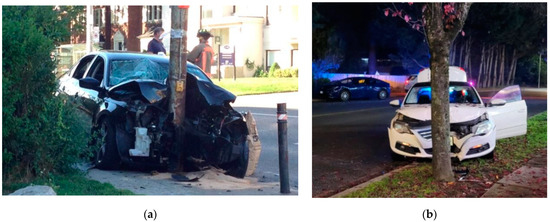
Figure 1.
Car collision:(a) with a utility pole; (b) with a tree next to the road.
Recently, roadside lighting poles have been subjected to high safety requirements and crash tests or simulations, but there are still poles that do not meet the safety requirements and pose a risk to drivers, as well as passengers. It is important to emphasize that roadside trees also remain a very serious road safety issue [14]. The safety of drivers and passengers involved in these types of accidents usually depends on the speed of the collision, the configuration, the dimensions of the stationary object, i.e., a pole or a tree, and, of course, on the safety of the vehicle structure; therefore, it is essential to assess the dangers of these objects and the possible consequences for the driver and passenger [15].
To refine the EES calculations, it is necessary to analyze the methods for estimating the energy equivalent of the vehicle damage and to perform simulations of a vehicle’s collision with a non-deformable wall and collision with an object simulating a utility pole or a tree using the LS DYNA R.11.0.0 software. Simulation of the impact process requires estimating the deformation of the vehicle with respect to the impact speed and configuration, determining the residual deformation to obtain the Energy Equivalent Speed (EES) values using the “Crash 3—EBS Calculation 12.0” software, and conducting a visual comparison with the EES catalog database.
The determination of the EES using the PC-Crash 12.0 software module “Crash 3—EBS Calculation 12.0” is influenced by the vehicles and their stiffnesses in the database. Crash experts must select a vehicle from the NHTSA database, and vehicles in the USA may have different stiffnesses than the vehicles on the European market. Measuring the depth of the deformation using an overhead photo is limited, especially in the case of lateral deformation of the vehicle, where the maximum depth of deformation may be covered by the roof or other parts of the vehicle. The EES values determined through comparison to the damage on a vehicle with a known EES value may not be accurate for modern vehicles, and EES catalogs typically do not include the latest vehicles.
While the methods described above assume that the stiffness of the front end of the vehicle is uniform, the novelty of the present work is that simulation with the LS DYNA R.11.0.0 software evaluates the different stiffnesses of the different parts of the vehicle.
2. Overview of the Methods for Estimating the EES of Vehicle Damage
2.1. Methodology for Calculating the Deformation Energy Based on Deformation Size
The researcher K. Campbell proposed assessing the severity of a collision by estimating the strain energy from the damage to the vehicle. On the basis of frontal crash tests, he found a direct dependence of the deformation energy on the deformed area of the body (as seen in the overhead projection), i.e., the force required to deform increases linearly with increasing deformation. Thus, the strain energy can be calculated from the residual strain, but it must be noted that the transverse strain propagation is also important [16].
The deformation energy of the vehicle during the collision is almost equal to the kinetic energy before the collision. In collisions with a concrete barrier at a 100% overlap (Figure 2), or in collisions where the vehicle has low kinetic energy, the following relationship applies: Kinetic energy = Deformation energy.

Figure 2.
Frontal impact on a concrete wall with 100% overlap.
For frontal impact tests on a concrete wall with 100% overlap, a linear dependence of velocity v on the magnitude of residual deflection was found:
b0—the speed at which residual deformation begins; b1—characteristic inclination, which describes the increase in residual deformation with the increase in speed during the impact; s—the depth of deformation of the car body (is measured directly in a real car after the accident or using the “Crash 3—EBS Calculation 12.0” software).
v = b0 + b1 · s,
The deformation energy is calculated:
If the deformation depth is represented as a band of a certain width (e.g., 0.1 m), these so-called energy zones can also be separated in the transverse direction (with respect to the longitudinal axis of symmetry of the vehicle). This method is known as the grid method (Figure 3).
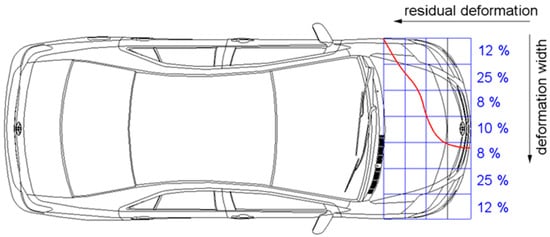
Figure 3.
Marking the depth of residual deformation.
The coefficients b0 and b1 are determined from the results of the impact tests (b0 = 4.46…6.19 km/h, b1 = 74.88…81.36 km/h) [4].
The calculation of the absorbed energy is based on the value of the residual deformation using K. Campbell’s mathematical model. The main difference is the consideration of the deformation energy without the residual strain, which is not constant or proportional to the area of the contact zone. The following relationship applies:
E—deformation energy; d0—width of damages; A, B, G—empirically determined stiffness coefficients; A—stiffness coefficient, which defines the magnitude of the contact forces on the deformed surface; B—stiffness coefficient in the automotive test, based on the depth of deformation; G—body stiffness coefficient.
The coefficients are calculated using the following formulas:
The German researchers H. Burg and F. Zeidler proposed denoting the deformation energy using Wdef and subsequently using this notation since the kinetic energy of a moving car is converted into the deformation work of the car body elements during a collision. Using the methodology of H. Burg and F. Zeidler, the deformation energy can be calculated:
The equivalent loss of speed for the plastic deformation of the body work is then [17]:
Knowing the stiffness of the car body and the depth of deformation, it is possible to determine the amount of strain energy lost to plastic deformation:
s—the depth of the deformation of the body (measured directly in a real car after the accident or using the “Crash 3—EBS Calculation 12.0” software).
The average stiffness values for car bodies are between 600 and 1000 kN/m [4].
The stiffness and strength of the front part of the car body are not uniform across the width, with load-bearing structural elements such as longerons on the sides and generally easily deformable elements in the middle. For this reason, it is appropriate to apply Formula (9) when the nature of the deformation of the car is like that of a vertical plate impact. If the car hits a stationary obstacle (pole, tree), or if the deformations are not symmetrical with respect to the longitudinal axis of the car, a grid calculation method can be used, which estimates the amount of energy consumed by the plastic deformation of the car body depending on the nature of the deformation. The deformation energy and the EES of the vehicles can be calculated using the “Crash 3—EBS Calculation 12.0” software in the PC-Crash 12.0 software environment, the principle of the calculation algorithm of which is based on the method of H. Mackay and K. Campbell. The “Crash 3—EBS Calculation 12.0” software contains the NHTSA database, which is based on frontal crash tests with a non-deformable barrier. “Crash 3—EBS Calculation 12.0” selects the car to analyze from the NHTSA database (Figure 4, right-hand side) and the corresponding car model, with the crash parameters determined during the test (Figure 4, left-hand side), from which it automatically calculates the stiffness parameters, A, B and G, required to calculate the EES parameter for the test car [18].
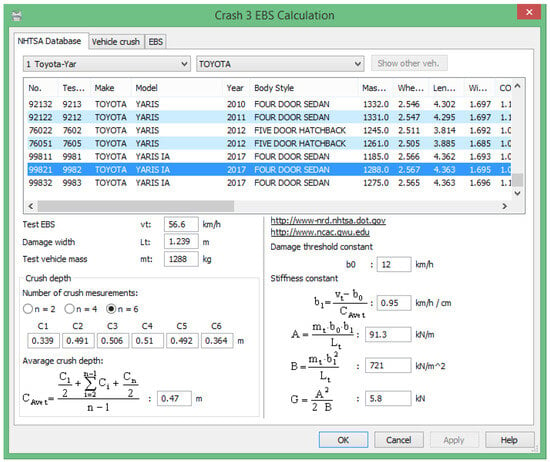
Figure 4.
Calculation of A, B, and G coefficients in “Crash 3—EBS Calculation 12.0”.
Once the width and depth of the deformation have been measured or visually assessed, the car is divided into segments (Figure 5).
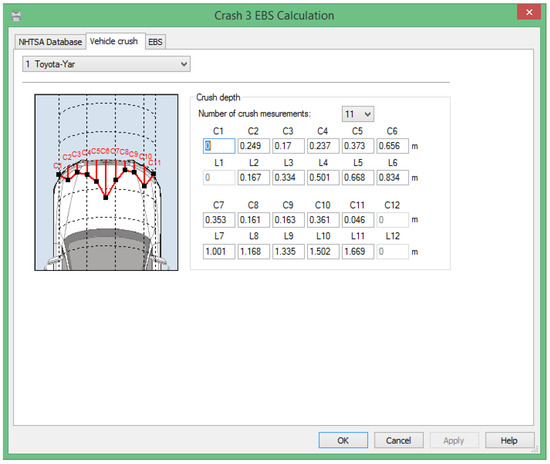
Figure 5.
Dividing the width of the damage (deformation) of the test vehicle into segments.
Then, at each point, the depth of the deformation and the angle at which the deformation acted are indicated. The deformation energy is then automatically calculated (Figure 6), and the value of the EES parameter is automatically calculated based on the EBS parameter through the value of the restoration coefficient [19].
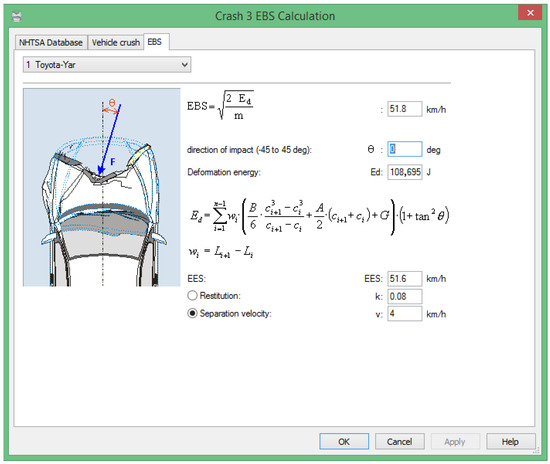
Figure 6.
An example of calculating the EES parameter.
It should be borne in mind that in these calculations, the average body stiffness is determined for the entire deformed area from the data of the test—a collision with a non-deformable barrier. In a specific case, it is necessary to compare whether this calculated stiffness compares with the stiffness of the deformed area of the damaged car. For collisions with a small degree of overlap or collisions with an acute angle, the calculated stiffness should be adjusted according to the methodology presented in the literature [20].
2.2. Calculation of the EES Parameter Based on the Deformed Volume
If the stiffness of the vehicle body is unknown, the deformation energy of passenger cars can be calculated from the deformed volume:
w—deformed width of the vehicle body; h—deformed height of the vehicle body; c—maximum depth of the deformation of the vehicle (measured from the original profile); ε—stiffness coefficient (coefficient of resistance to deformations).
Ed = 0.5 · w · h · c2 · ε,
The EES is calculated using the following formula:
For cars of different sizes, produced in different periods, the values of the deformation resistance coefficient ε are within the following limits [21,22]:
- (1)
- 9.0 × 105…11 × 105 N/mm2, when the car strength structure was broken as a result of the deformations;
- (2)
- 2.0 × 105…4.0 × 105 N/mm2, when the deformations are located only in the skin plate elements;
- (3)
- When the car strength structure was broken:
- (a)
- 13.5 × 105…22.6 × 105 N/mm2 for small cars;
- (b)
- 9.1 × 105…13.5 × 105 N/mm2 for medium cars;
- (c)
- 5.2 × 105…7.2 × 105 N/mm2 for large cars.
2.3. Application of the EES Catalog to Estimating the Energy Equivalent
The EES catalog [18] can be used to estimate the energy equivalent of vehicle damage. The EES catalog is a database that contains photos of various car crash tests. Tests are carried out with different cars at different car speeds and using different collision types. Most often, traffic accident experts are not presented with the objects of the investigation themselves, i.e., the vehicles damaged during a traffic accident; instead, only photos of their damage are sent. The traffic accident expert, having photos of the car under investigation, first determines the localization of the damage after assessing the nature and intensity of the damage. Secondly, from the EES catalog, the same model as the car under study is chosen, and the nature and intensity of the deformation visible in the photos of the car under study are visually compared with the deformations of cars of the same model in the EES catalog. If the EES catalog does not have a car of the same model as the one under study, or if the car under study and the car of the same model in the EES catalog have a significant difference in their natures, as well as in the intensity of the deformations, then a car of another model that is more similar in terms of its geometric shape and body stiffness is selected from the EES catalog, and after comparing their deformations (location, nature, and intensity), the closest option is selected (Figure 7). This visual method of evaluating the energy equivalent of vehicle damage is simple, does not take much time, and is widely used in the practice of traffic accidents. However, it is not accurate enough since the EES catalog does not contain photos of damage to all car models with residual deformations after collision tests, and in addition, each collision is different, so estimating the car’s speed equivalent to the kinetic energy absorbed for car deformations based on the photos in the EES catalog can only be approximate. Another drawback is that the EES catalog does not contain the latest crash test results for the car models; they are updated only after a certain period of time.
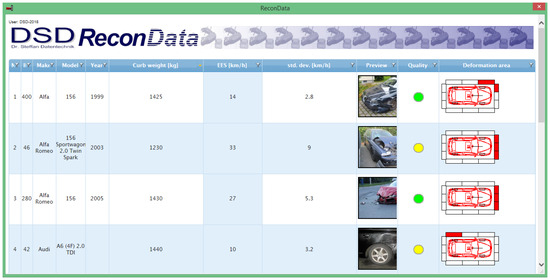
Figure 7.
EES catalog with examples of various car deformations for setting the EES parameter:  —high quality of EES parameter;
—high quality of EES parameter;  —medium quality of EES parameter.
—medium quality of EES parameter.
 —high quality of EES parameter;
—high quality of EES parameter;  —medium quality of EES parameter.
—medium quality of EES parameter.
When applying the EES comparison method, where car deformations are visually compared with car deformations from the known EES catalog, it is important to estimate the difference in the car weights by applying the appropriate formula [23,24,25]:
metalon—mass of the car selected from the catalog; mvehicle—the mass of the deformed vehicle under consideration; EESetalon—the value of the car energy equivalent speed parameter selected from the catalog.
2.4. Analysis of the Methods Used to Estimate the Energy Equivalent of Vehicle Damage When Hitting a Utility Pole or a Tree
The analyzed methods are applied in cases when the tree or pole does not break, and if it does break and the speed of the vehicle after the impact is insignificantly low, the formulas can be applied only if the vehicle hits an obstacle in the frontal plane [26]. According to a method proposed by the National Transportation Safety Board (NTSB), it is possible to calculate the vehicle speed equivalent to the kinetic energy expenditure in the body damage caused by hitting a tree. This method is not widely used, but it is still employed by the NTSB:
BP0, BP1—constants depending on the mass of the vehicle (Table 1); cmax—maximum depth of the vehicle deformations.
EES = BP0 + BP1 · cmax

Table 1.
Values of constants BP0 and BP1 [26].
According to the method proposed by Nystrom and Kost [27], it is possible to estimate the EES parameter of a vehicle when it hits a tree or a pole by applying a formula analogous to the formula proposed by the NTSB, only with different values of the constants presented in Table 2.

Table 2.
Values of constants BP0 and BP1 [26,27].
The evaluation of the EES parameter according to V. Craig [28] is unique in that the depth of the maximum static crush is approximately equal to the impact speed of the vehicle (Table 3).

Table 3.
Estimation of energy equivalent according to Craig’s method [28,29].
These formulas are not widely used in professional practice because there are not enough reliable data on their accuracy.
3. Evaluation of the Energy Equivalent of Vehicle Damage Using LS DYNNA
Vehicle crash analysis is an area where finite element models provide reliable results [30]. The LS DYNA R.11.0.0 software is widely used to simulate car crash safety tests [31,32]. Car manufacturers, car testers, and other institutions involved in car transportation use this software to perform various simulations and calculations, such as simulations of car collisions, seat belt effectiveness, or car body deformation [33]. In addition, LS DYNA R.11.0.0 allows for the use of finite element models of cars that are freely available to all users, which, in turn, provides good conditions for researchers to perform simulations of issues of interest to them. For these reasons, LS DYNA R.11.0.0 is used in this study to perform computer simulations of collisions with a non-deformable wall and with an object simulating a pole/tree.
The finite element model of the Toyota Yaris developed by the National Crash Analysis Center (NCAC) and used for the simulation is intended for use in the LS DYNA R.11.0.0 software environment; this car model has detailed and accurate components of the real car (Figure 8). The Toyota Yaris model consists of 378,376 elements, 393,165 nodes, and 919 parts, while the mass of the car model is 1101 kg. This model of the Toyota Yaris is validated in various collision scenarios [34].
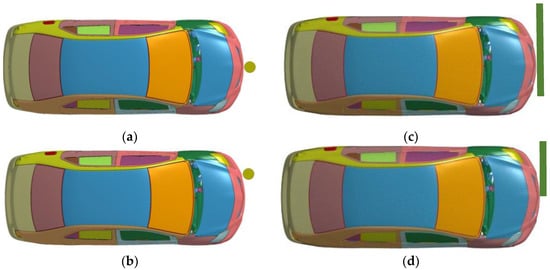
Figure 8.
Visual view of the Toyota Yaris before collision: (a) impact velocity—50 km/h, object—200 mm pole, object position—center; (b) impact velocity—50 km/h, object—200 mm pole, object position—25% offset; (c) impact velocity—50 km/h, object—wall, object position—100% overlap; (d) impact velocity—50 km/h, object—wall, object position—50% overlap.
Simulation of a Collision with a Fixed Object and a Non-Deformable Wall
Utility poles made of steel or concrete are widely used in highway and street lighting systems or structural applications, whereas trees grow near roads, homes, or multi-purpose buildings near roads. Because these objects are usually non-deformable or slightly deformed during collisions, collisions with them are dangerous enough. In this study, a non-deformable cylindrical object simulating a pole/tree and a non-deformable wall are used. Considering the objects used and encountered in the road infrastructure, the diameter of the pole/tree simulating object in the study is selected to be 200 mm [26].
The Toyota Yaris collision simulations are performed while the car is moving at a speed of 50 km/h. This speed is chosen based on the commonly used speed limits in cities and towns. The simulations use four different cases of frontal contact of a car with an object (fixed) simulating a pole/tree and a non-deformable wall. In the first case, the car hits the object simulating a pole/tree with the impact at the center of the car (Figure 8a); in the second case, the car hits the object simulating a pole/tree with a 25% overlap (Figure 8b); in the third case, the car hits the non-deformable wall with 100% overlap (Figure 8c); and in the fourth case, the car hits the non-deformable wall with a 50% overlap (Figure 8d). The duration of each collision simulation is 120 ms.
During the simulations, four different situations were analyzed. It should also be noted that the simulations in LS DYNA R.11.0.0 are performed with double precision—SMP double. Double precision is used in simulations because it gives more accurate simulation results, but it should be noted that, in this case, the simulation takes about 30% more time than single-precision simulation [35].
4. Results
4.1. Deformation Analysis
The simulations performed using the LS DYNA R.11.0.0 software produced deformations in the Toyota Yaris. Figure 9 shows the deformation of the vehicles at the end of the collision in each case.

Figure 9.
Visual view of the Toyota Yaris after collision: (a) impact velocity—50 km/h, object—200 mm pole, object position—center; (b) impact velocity—50 km/h, object—200 mm pole, object position—25% offset; (c) impact velocity—50 km/h, object—wall, object position—100% overlap; (d) impact velocity—50 km/h, object—wall, object position—50% overlap.
The simulation results show that the Toyota Yaris, after a center-on-center collision with a tree/pillar object, has frontal crush in a sufficiently narrow area from the front to the rear of the car. In this case, the highest concentration of damage is in the center of the car. When the Toyota Yaris collides with the tree/pole with 25% overlap, the left side of the front end of the car is crushed from the front to the rear. The deformation in this case is quite deep compared to in other cases.
The simulation results also show that the Toyota Yaris suffered a full-width frontal crush from front to rear at 100% overlap after a collision with a non-deformable wall. In the case of a collision with a non-deformable wall at a 50% overlap, the left side of the front end of the car is crushed from the front to the rear. Visual assessment of the deformations in all cases shows that the depth of the residual deformation depends on the position of the object at the time of impact and the contact area.
4.2. Speed Variation Analysis
Plots of the velocity change at the center of gravity during a collision with an object simulating a pole/tree are shown in Figure 10. These graphs show the change in the vehicle speed during the collision at each time point. From the graphs, it can be seen that the change in speed is strongly dependent on the position of the obstacle relative to the vehicle. When the car hits a fixed object at a 25% overlap, the change in speed varies quite smoothly and lasts for a longer period compared to the case where the car hits an object with the impact at its center. In this case, i.e., a car hitting an object with the impact at its center, a sudden change in velocity between 0.03 s and 0.04 s is observed.
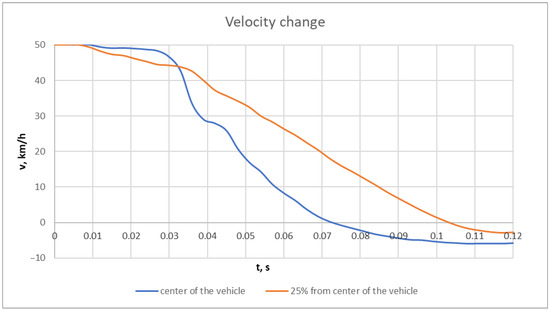
Figure 10.
Velocity change upon impact of the car with the 200 mm diameter solid object.
This sudden and relatively large change in velocity in a very short time may be due to the interaction of very stiff parts of the car that are more resistant to deformation.
Plots of the velocity change during the impact with the non-deformable wall are shown in Figure 11. From the plots, there is no significant difference in the change in velocity depending on the overlap of the car with the non-deformable wall at the time of impact. The change in velocity between 100% and 50% overlap of the car hitting the non-deformable wall is quite uniform and lasts for a similar period.
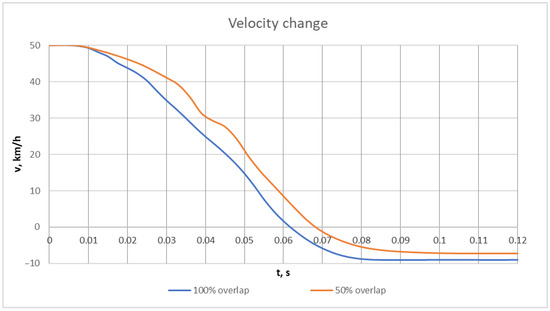
Figure 11.
Velocity change upon impact of the car with the non-deformable wall.
4.3. Longitudinal Acceleration Analysis
The deceleration/acceleration at the time of the collision is an excellent indicator of the severity of the impact and the risk of injury to the driver and the occupants of a vehicle. The longitudinal acceleration plots for a collision with an object simulating a pole/tree are shown in Figure 12. The longitudinal acceleration plots show that the maximum longitudinal acceleration occurs when the car hits a solid object in the center. In this case, the maximum longitudinal deceleration for an object with a diameter of 200 mm is about 64 g. In the case of a car hitting a solid object with 25% overlap, the longitudinal accelerations are much smaller. For a car hitting a fixed object having a diameter of 200 mm with 25% overlap, the maximum longitudinal acceleration is 23 g.
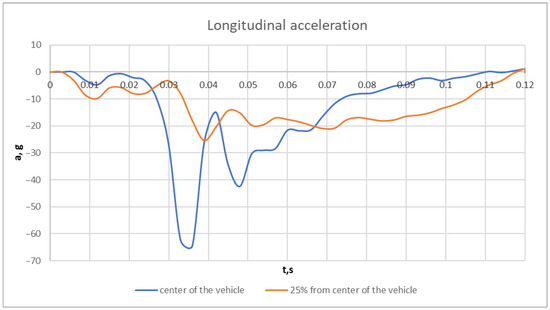
Figure 12.
Longitudinal acceleration upon impact of the car with a solid object having a diameter of 200 mm.
From the longitudinal acceleration plots obtained, it can be concluded that the position of the fixed object relative to the car has a significant influence on the longitudinal acceleration during the impact. As a result, a collision with a fixed object in the center is more dangerous because it produces higher accelerations, which can cause a significant risk to the safety of the driver and passengers.
Longitudinal acceleration graphs for a collision with a non-deformable wall are shown in Figure 13. The longitudinal acceleration graphs show that a slightly higher longitudinal acceleration occurs when the car hits a non-deformable wall with 50% overlap. In this case, the maximum longitudinal deceleration/acceleration is about 42 g. In the case of a car hitting a non-deformable wall with 100% overlap, the value of the longitudinal acceleration is about 40 g. The acceleration values obtained are similar to those obtained by other researchers [36,37]. In this case, the difference in longitudinal acceleration is not significant.
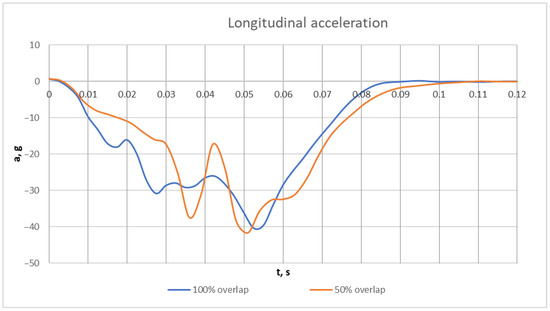
Figure 13.
Longitudinal acceleration upon impact of the car with the non-deformable wall.
4.4. Speed Adjustment
The residual deformation of vehicles is very important in the analysis of vehicle collisions, as the deformation can help determine the speed of the vehicles just before the collision, which is important in the analysis of traffic accidents. The residual deformations from the Toyota Yaris crash are then used to derive the EES values from the “Crash 3—EBS Calculation 12.0” software and for a visual comparison with the EES catalog database.
The “Crash 3—EBS Calculation 12.0” software was used to obtain the EES parameter values for a collision with a pole/tree simulated object. For a collision where the car hits a pole/tree with 25% overlap (edge), the calculated EES parameter value is 53.5 km/h (Figure 14). On the same basis, the value of the EES parameter is calculated for a collision where the car hits the object simulating a pole/tree with the impact at its center. In this case, the value of the EES parameter is 51.6 km/h.
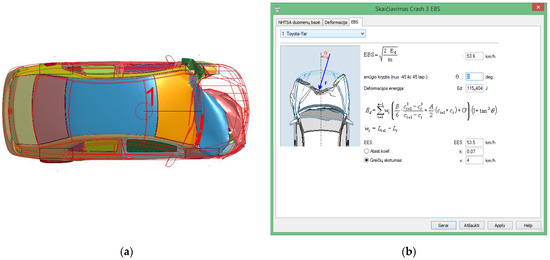
Figure 14.
(a) Deformation of Toyota Yaris after the collision with the pole/tree object; (b) “Crash 3—EBS Calculation 12.0” calculation window.
The “Crash 3—EBS Calculation 12.0” software was then used to obtain the values of the EES parameters in the case of a collision with a non-deformable wall. In the case of a Toyota Yaris hitting a non-deformable wall with 100% overlap, the calculated value of the EES parameter is 54.4 km/h (Figure 15). Similarly, a simulation was performed for a car hitting a wall with 50% overlap, with an EES parameter value of 50.7 km/h.

Figure 15.
(a) Deformation of Toyota Yaris after the collision with the non-deformable wall; (b) “Crash 3—EBS Calculation 12.0” calculation window.
A visual comparison with the EES catalog data is also made to assess the type, extent, and intensity of the damage to the Toyota Yaris following the collision with the pole/tree simulant with 25% overlap. As EES values for the Toyota Yaris are not available in the database, a Hyundai Getz of the same class (City and Supermini according to EURONCAP) is selected in this case, considering the damage (Figure 16).
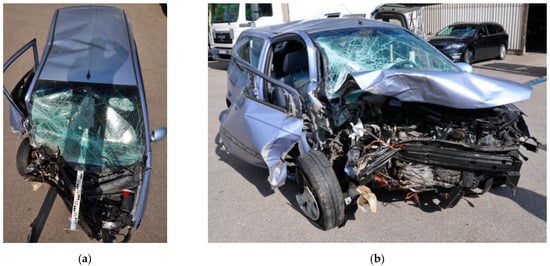
Figure 16.
Frontal deformation image of a Hyundai Getz of the same class in the EES catalog: (a) top view; (b) front view.
According to the EES catalog database, the EES value of the Hyundai Getz is 52.5 km/h. However, to obtain more accurate results, it is important to recalculate the EES parameter value to consider the difference in mass of the cars according to Formula (12):
A visual comparison of the deformation of the Toyota Yaris with that of a car of the same class in the EES catalog and a recalculation of the EES value due to the difference in the masses of the cars being compared resulted in an EES value of 47.9 km/h for the Toyota Yaris using this method. On the same basis, the value of the EES parameter is obtained for a case of a collision where the car hits an object simulating a pole/tree with the impact on the center of the car. In this case, the above-mentioned comparisons and calculations result in an EES parameter value of 48.8 km/h.
A visual comparison with the data in the EES catalog is made to further assess the type, extent, and intensity of damage to the Toyota Yaris following a collision with a non-deformable wall with 100% overlap. As EES values for the Toyota Yaris are not available in the database, a Fiat Panda of the same class (City and Supermini according to EURONCAP) is selected for this case, considering the damage (Figure 17).
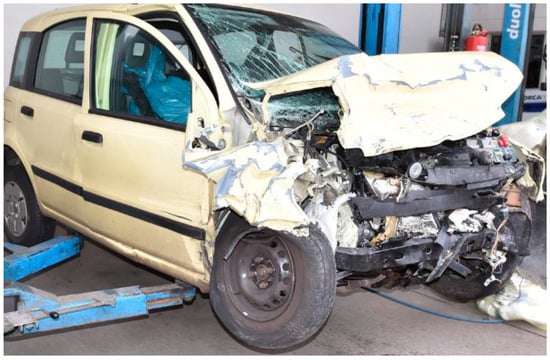
Figure 17.
Frontal deformation image of a Fiat Panda of the same class in the EES catalog.
According to the EES catalog database, the EES value for this car is about 51.9 km/h. The value of the EES parameter is then recalculated to account for the difference in the mass of the cars according to the established formula:
A visual comparison of the deformation of the Toyota Yaris with that of a car of the same class in the EES catalog, and a recalculation of the EES value due to the difference in the masses of the cars being compared, resulted in an EES value of 48.0 km/h for the Toyota Yaris using this method. On the same basis, the value of the EES parameter is obtained for a collision with a car hitting a non-deformable wall with 50% overlap. In this case, the above-mentioned comparisons and calculations result in an EES parameter value of 50.6 km/h. The final results and a comparison of the differences obtained are shown in Table 4. The EES values obtained are similar to those obtained by other researchers [38].

Table 4.
Comparison of EES values obtained using different methods with simulation results.
5. Conclusions
In most cases, there are no data on the stiffness of the body of a particular car. The average stiffness values for car bodies are between 500 and 1000 kN/m, but the stiffness and strength of the front part of the body vary from side to side, with load-bearing elements such as side members on the sides and generally easily deformable elements in the center. For this reason, the formula proposed by the German researchers H. Burg and F. Zeidler for the calculation of the EES parameter, based on the stiffness of the body and the depth of the deformation, should be applied when the stiffness of the specific parts of the car body is known because taking the minimum and maximum stiffness values for the calculations and finally calculating the speed of the vehicle will result in a difference that can sometimes have a decisive influence on the final conclusion of an accident’s investigation.
When calculating the EES parameter from the deformed volume, it is necessary to have the deformation parameters (deformation height, width, depth) needed to calculate the deformation energy, but in most cases the accident experts are not provided with the objects of investigation, i.e., the vehicles damaged in the accident, only with photographs of the damage to the vehicles, which usually lack the parameters needed for the calculations. In addition, this method requires that the area of the deformation is close to rectangular or square; otherwise, the calculations will have a large error.
The EES values obtained using the EES catalog compared to the simulated EES parameter values vary from 1.19% to 4.29%. This method gives the largest difference in the EES parameter in the case of a car hitting a pole/tree simulating an object with 25% overlap. In three of the four cases, the EES values obtained using this method are lower than the EES values obtained using LS DYNA R.11.0.0 simulation. The only case where the EES value is higher using this method is a collision with a non-deformable wall at 50% overlap.
The EES parameter values calculated using “Crash 3—EBS Calculation 12.0” differ from the EES parameter values obtained using LS DYNA R.11.0.0 simulation by between 1.39% and 8.43%, depending on the type of impact. The highest difference is obtained in the case of a car hitting a wall with 100% overlap. The EES parameter values obtained using the “Crash 3—EBS Calculation 12.0” software are, in all cases, higher than the EES value obtained using LS DYNA R.11.0.0 simulation. “Crash 3—EBS Calculation 12.0” uses the NHTSA database based on frontal crash tests of American cars with a non-deformable barrier to calculate the stiffness factors. The safety requirements for US cars are slightly different from the European standards, as are the design details of American cars, and detailed data on these differences and their effect on the stiffness of the body structure are not available. “Crash 3—EBS Calculation 12.0” is most relevant for non-deformed wall crashes. In the case of a small overlap, a deformable wall, or a two-vehicle collision, this calculation method may not be accurate.
Author Contributions
Conceptualization, P.D., R.P. and T.P.; methodology, P.D. and T.P.; software, T.P. and R.P.; validation, T.P., R.P. and S.P.; formal analysis, P.D.; investigation, T.P.; writing—original draft preparation, P.D., T.P. and R.P.; writing—review and editing, S.P.; supervision, P.D. and S.P.; project administration, P.D. All authors have read and agreed to the published version of the manuscript.
Funding
This research received no external funding.
Data Availability Statement
The raw data supporting the conclusions of this article will be made available by the authors on request.
Conflicts of Interest
The authors declare no conflicts of interest.
References
- World Health Organization. Global Status Report on Road Safety 2023; World Health Organization: Geneva, Switzerland, 2023; ISBN 978-92-4-008651-7.
- Chang, F.-R.; Huang, H.-L.; Schwebel, D.C.; Chan, A.H.S.; Hu, G.-Q. Global Road Traffic Injury Statistics: Challenges, Mechanisms and Solutions. Chin. J. Traumatol. 2020, 23, 216–218. [Google Scholar] [CrossRef]
- Gidlewski, M.; Prochowski, L.; Jemioł, L.; Żardecki, D. The Process of Front-to-Side Collision of Motor Vehicles in Terms of Energy Balance. Nonlinear Dyn. 2019, 97, 1877–1893. [Google Scholar] [CrossRef]
- Burg, H.; Moser, A. (Eds.) Handbuch Verkehrsunfallrekonstruktion: Unfallaufnahme, Fahrdynamik, Simulation; ATZ/MTZ-Fachbuch; 3. aktualisierte Auflage; Springer Vieweg: Wiesbaden, Germany, 2017; ISBN 978-3-658-16142-2. [Google Scholar]
- Vangi, D. Energy Loss in Vehicle to Vehicle Oblique Impact. Int. J. Impact Eng. 2009, 36, 512–521. [Google Scholar] [CrossRef]
- Kubiak, P.; Siczek, K.; Dąbrowski, A.; Szosland, A. New High Precision Method for Determining Vehicle Crash Velocity Based on Measurements of Body Deformation. Int. J. Crashworthiness 2016, 21, 532–541. [Google Scholar] [CrossRef]
- Breitlauch, P.; Erbsmehl, C.T.; Van Ratingen, M.; Mallada, J.L.; Sandner, V.; Ferson, N.; Urban, M. A Novel Method for the Automated Simulation of Various Vehicle Collisions to Estimate Crash Severity. Traffic Inj. Prev. 2023, 24, S116–S123. [Google Scholar] [CrossRef] [PubMed]
- Vangi, D.; Begani, F. Energy Loss in Vehicle Collisions from Permanent Deformation: An Extension of the ‘Triangle Method’. Veh. Syst. Dyn. 2013, 51, 857–876. [Google Scholar] [CrossRef]
- Mackay, G.M.; Hill, J.; Parkin, S.; Munns, J.A.R. Restrained Occupants on the Nonstruck Side in Lateral Collisions. Accid. Anal. Prev. 1993, 25, 147–152. [Google Scholar] [CrossRef] [PubMed]
- Uddin, M.S.; Quintel, J.; Zivkovic, G. On the Design of Energy Absorbing Crash Buffers for High Speed Roadways. Open J. Saf. Sci. Technol. 2016, 06, 11–24. [Google Scholar] [CrossRef]
- Alardhi, M.; Sequeira, R.; Melad, F.; Alrajhi, J.; Alkhulaifi, K. Crashworthiness Analysis to Evaluate the Performance of TDM-Shielded Street Poles Using FEA. Appl. Sci. 2023, 13, 4393. [Google Scholar] [CrossRef]
- Zheng, L.; Sayed, T. Utility Poles. In International Encyclopedia of Transportation; Elsevier: Amsterdam, The Netherlands, 2021; pp. 731–736. ISBN 978-0-08-102672-4. [Google Scholar]
- IIHS. Collisions with Fixed Objects and Animals 2023. Available online: https://www.iihs.org/topics/fatality-statistics/detail/collisions-with-fixed-objects-and-animals#fn1 (accessed on 10 January 2024).
- Baranowski, P.; Damaziak, K. Numerical Simulation of Vehicle–Lighting Pole Crash Tests: Parametric Study of Factors Influencing Predicted Occupant Safety Levels. Materials 2021, 14, 2822. [Google Scholar] [CrossRef]
- Ispas, N.; Nastasoiu, M. Analysis of Car’s Frontal Collision against Pole. IOP Conf. Ser. Mater. Sci. Eng. 2017, 252, 012012. [Google Scholar] [CrossRef]
- Campbell, K.L. Energy Basis for Collision Severity. SAE Trans. 1974, 83, 2114–2126. [Google Scholar]
- Kubiak, P.; Mierzejewska, P.; Szosland, A. A Precise Method of Vehicle Velocity Determination Based on Measurements of Car Body Deformation—Non-Linear Method for the ‘Luxury’ Vehicle Class. Int. J. Crashworthiness 2018, 23, 100–107. [Google Scholar] [CrossRef]
- Dr. Steffan PC Crash. DSD ReconData 2018. Available online: https://www.dsd.at/index.php?option=com_content&view=article&id=512:pc-crash-englisch-3&catid=37&lang=en&Itemid=159 (accessed on 20 February 2024).
- Wach, W. Symulacja Wypadków Drogowych w Programie PC-Crash; Wydawnictwo Instytutu Ekspertyz Sądowych: Kraków, Poland, 2009; ISBN 978-83-87425-23-4. [Google Scholar]
- Niehoff, P. The Accuracy of Energy-Based Crash Reconstruction Techniques Using e Using Event Data r Ent Data Recorder Measur Der Measurements. Master’s Thesis, Rowan University, Glassboro, NJ, USA, 2005. [Google Scholar]
- Prochowski, L.; Unarski, J.; Wach, W.; Wicher, J. (Eds.) Podstawy Rekonstrukcji Wypadków Drogowych; Pojazdy Samochodowe; Wyd. 2. uaktualnione; Wydawnictwa Komunikacji i Łączności: Warszawa, Poland, 2014; ISBN 978-83-206-1940-9. [Google Scholar]
- Kubiak, P.; Wozniak, M.; Ozuna, G. Determination of the Energy Necessary for Cars Bodydeformation by Application of the NHTSA Stifness Coefficient. Mach. Technol. Mater. 2014, VIII, 38–40. [Google Scholar]
- Moravcová, P.; Bucsuházy, K.; Bilík, M.; Belák, M.; Bradáč, A. Let It Crash! Energy Equivalent Speed Determination. In Proceedings of the 7th International Conference on Vehicle Technology and Intelligent Transport Systems, Virtual, 28–30 April 2021; SCITEPRESS—Science and Technology Publications. pp. 521–528. [Google Scholar]
- Bucsuházy, K.; Matuchová, E.; Zůvala, R.; Moravcová, P.; Kostíková, M.; Mikulec, R. Human Factors Contributing to the Road Traffic Accident Occurrence. Transp. Res. Procedia 2020, 45, 555–561. [Google Scholar] [CrossRef]
- Macurová, Ľ.; Kohút, P.; Čopiak, M.; Imrich, L.; Rédl, M. Determinig the Energy Equivalent Speed by Using Software Based on the Finite Element Method. Transp. Res. Procedia 2020, 44, 219–225. [Google Scholar] [CrossRef]
- Cofone, J.N.; Rich, A.S.; Scott, C.A. A Comparison of Equations for Estimating Speed Based on Maximum Static Deformation for Frontal Narrow-Object Impacts. Accid. Reconstr. J. 2007, 11, 19–27. [Google Scholar]
- Nystrom, G.A.; Kost, G. Application of the NHTSA Crash Database to Pole Impact Predictions. SAE Tech. Pap. 1992, 920605. [Google Scholar]
- Craig, V. Analysis of Pole Barrier Test Data and Impact Equations. Accid. Reconstr. J. 1993, 9. [Google Scholar]
- Burdzik, R.; Folęga, P.; Konieczny, Ł.; Łazarz, B.; Stanik, Z.; Warczek, J. Analysis of Material Deformation Work Measures in Determination of a Vehicle’s Collision Speed. Arch. Matrials Sci. Eng. 2012, 58, 13–21. [Google Scholar]
- Noorsumar, G.; Rogovchenko, S.; Robbersmyr, K.G.; Vysochinskiy, D. Mathematical Models for Assessment of Vehicle Crashworthiness: A Review. Int. J. Crashworthiness 2022, 27, 1545–1559. [Google Scholar] [CrossRef]
- Goehner, U. Car Crash Simulations and Occupant Safety with LS-DYNA. In Proceedings of the EnginSoft International Conference 2009, Bergamo, Italy, 1–2 October 2009. [Google Scholar]
- Stein, M.; Schwanitz, P.; Sankarasubramanian, H. Unified Parametric Car Model—A Simplified Model for Frontal Crash Safety; DYNAmore GmbH: Ulm, Germany, 2012. [Google Scholar]
- Mertler, S.; Borsotto, D.; Jansen, L.; Thole, C.-A. Combined Analysis of Ls-Dyna Crash-Simulations and Crash-Test Scans. In Proceedings of the 15th International LS-DYNA® Users Conference, Dearborn, MI, USA, 10–12 June 2018. [Google Scholar]
- Reichert, R.; Park, C.; Morgan, R.M. Development of Integrated Vehicle-Occupant Model for Crashworthiness Safety Analysis; National Highway Traffic Safety Administration: Washington, DC, USA, 2014; p. 106.
- Lin, Y.-Y. Performance of LS-DYNA with Double Precision on Linux and Windows CCS. In Proceedings of the 6th European LS-DYNA Users’ Conference, Gothenburg, Sweden, 29–30 May 2007. [Google Scholar]
- Zhang, J.; Wang, L.; Wang, T.; Sun, H.; Zou, X.; Yuan, L. Frontal Crashworthiness Optimization for a Light-Duty Vehicle Based on a Multi-Objective Reliability Method. Int. J. Crashworthiness 2023, 28, 449–461. [Google Scholar] [CrossRef]
- Wågström, L.; Kling, A.; Norin, H.; Fagerlind, H. A Methodology for Improving Structural Robustness in Frontal Car-to-Car Crash Scenarios. Int. J. Crashworthiness 2013, 18, 385–396. [Google Scholar] [CrossRef]
- Kubiak, P.; Krzemieniewski, A.; Lisiecki, K.; Senko, J.; Szosland, A. Precise Method of Vehicle Velocity Determination Basing on Measurements of Car Body Deformation–Non-Linear Method for ‘Full Size’ Vehicle Class. Int. J. Crashworthiness 2018, 23, 302–310. [Google Scholar] [CrossRef]
Disclaimer/Publisher’s Note: The statements, opinions and data contained in all publications are solely those of the individual author(s) and contributor(s) and not of MDPI and/or the editor(s). MDPI and/or the editor(s) disclaim responsibility for any injury to people or property resulting from any ideas, methods, instructions or products referred to in the content. |
© 2024 by the authors. Licensee MDPI, Basel, Switzerland. This article is an open access article distributed under the terms and conditions of the Creative Commons Attribution (CC BY) license (https://creativecommons.org/licenses/by/4.0/).